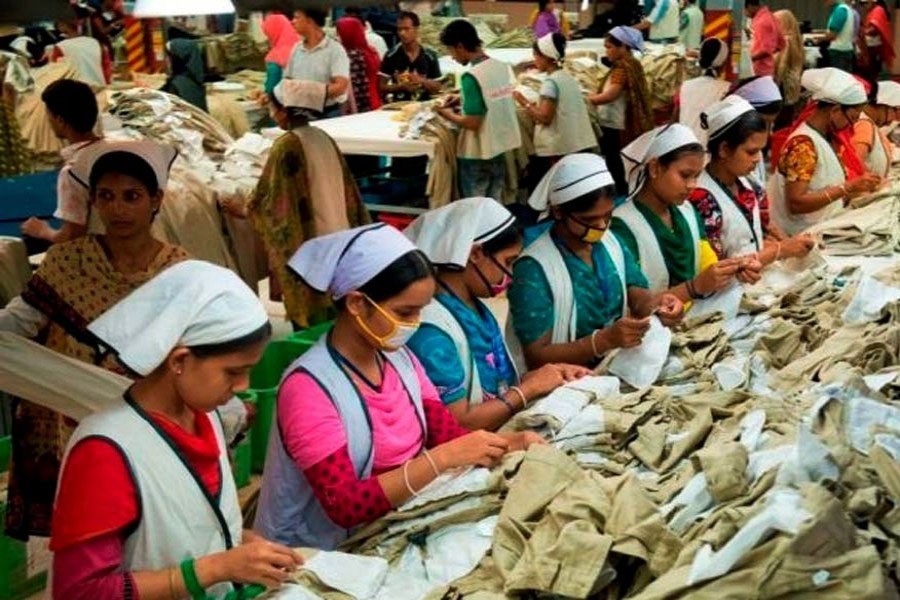Global ratings agency Moody's has predicted the economic activity in Bangladesh will decelerate sharply over the next 18 months in the aftermath of COVID-19 outbreak.
"…. domestic activity restrictions during the national lockdown will hamper consumption and investment and the weak global economy will lead to declines in RMG exports," the US-based Moody's Investors Service said in its latest report on Bangladesh rating on Monday.
The Moody's projected that the real gross domestic product or GDP growth will slow to 4.6 per cent in fiscal 2020 and to 4.2 per cent in fiscal 2021.
"This fall is aligned with our global view of a deep but temporary slowdown in global growth. However, even at these levels, growth will remain above the median that for Ba-rated sovereigns," it noted.
The temporary slowdown comes as Bangladesh has had a prolonged period of robust growth in the past two decades, supported by low labour costs and productivity gains amid a shift from agriculture to manufacturing and services, it noted.
Because of disruptions caused by the contagion, many Bangladeshi apparel factories that source raw materials and parts from China are facing difficulties.
The ratings agency, however, expects this situation to be temporary, with supply chains and demand starting to recover later in the fiscal year 2021.
The combination of both weaker oil prices and restrictions on the arrivals of foreigners in many Gulf Cooperation Council countries because of the outbreak of the coronavirus are risks to the flow of remittances into Bangladesh.
"… the disruptions caused by the outbreak of the coronavirus in Gulf Cooperation Council countries that have weakened remittances from Bangladeshi workers abroad will cause significant disruptions to economic activity in Bangladesh," the agency warned.
Bangladesh is rated Ba3 with a stable outlook further, according to the Moody's analysis.
The credit rating agency has rated Bangladesh's outlook as stable for the past 10 consecutive years, according to officials.
"Despite all these domestic and global challenges, we're happy to maintain our stable outlook with same Ba3 rating," Dr Habibur Rahman, executive director and chief economist (in charge) of the Bangladesh Bank (BB) told the FE.
The Moody's said the rating could be downgraded if there is a marked deterioration in the government's fiscal position.
This could occur through large borrowing to fund infrastructure projects that do not provide commensurate economic returns, an erosion in the government's revenue base or a sharp increase in financing costs, it said.
"Any of these events would significantly weaken the strength of the financial sector. Specifically, increased contingent liability risks from state-owned banks or signs that a period of greater financial stress that would impair macroeconomic and external conditions would be credit negative," the Moody's warned.
In contrast, the rating could be upgraded if there is a durable and substantial improvement in Bangladesh's finances beyond current expectations.
This is likely to come from an improvement in the government's revenue-generation capacity and a lower cost of financing, both of which would improve debt affordability and allow the government greater fiscal flexibility.
Referring to governance challenges, the agency said the potential time and uncertainty related to the length of the judiciary processes is significant.
"Borrowers often exploit this aspect of the legal system to disrupt default proceedings, resulting in higher credit risk and non-performing loans," the ratings agency noted.
The Moody's assessment incorporates financial sector weaknesses because of contingent liabilities posed by state-owned banks, which have solvency metrics weaker than rated banks.
"Our banking sector credit event assessment incorporates risks from state-owned commercial banks, despite rated banks not representing the full landscape of financial institutions," the agency explained.
"Weaknesses in state banks stifle lending to the real economy as banking system liquidity is concentrated in this sector," according the Moody's 28-page analysis, which was submitted to the central bank as well as the government on Monday for consideration.
State banks' NPLs are around 30 per cent of total loans, with an additional 20 per cent classified as rescheduled and restructured.
These levels are much higher than those in the private commercial banks, which have around 5.0 per cent NPLs and 10 per cent classified as rescheduled and restructured.
Financial stability or contingent liability risks arising from the weak state lenders are nevertheless lower than implied by the high NPLs and low capital adequacy ratios.
The loan market share of state-owned banks has declined to below 20 per cent of total banking system advances, as private commercial banks have been responsible for the bulk of credit growth.
"Liquidity remains abundant throughout the banking system, and the SoCBs benefit from excess liquidity because of the large amounts of retail and SOE deposits," the agency said in its analysis.
Regarding the single digit interest rate, the Moody's said the implementation of interest caps will not lead to an improved credit transmission channel and could potentially lead to credit rationing.
"It could also lead to an improper pricing risk in the market and potentially further squeeze margins at banks and lead to an acceleration in NPLs," the global rating agency noted.
On February 24, the central bank instructed all banks to fix a maximum of 9.0 per cent interest rate on loans as part of the government step to bring down the rate to a single-digit from April 01.


